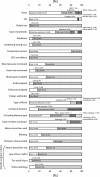Method parameters' impact on mortality and variability in rat stroke experiments: a meta-analysis
- PMID: 23548160
- PMCID: PMC3637133
- DOI: 10.1186/1471-2202-14-41
Method parameters' impact on mortality and variability in rat stroke experiments: a meta-analysis
Abstract
Background: Even though more than 600 stroke treatments have been shown effective in preclinical studies, clinically proven treatment alternatives for cerebral infarction remain scarce. Amongst the reasons for the discrepancy may be methodological shortcomings, such as high mortality and outcome variability, in the preclinical studies. A common approach in animal stroke experiments is that A) focal cerebral ischemia is inflicted, B) some type of treatment is administered and C) the infarct sizes are assessed. However, within this paradigm, the researcher has to make numerous methodological decisions, including choosing rat strain and type of surgical procedure. Even though a few studies have attempted to address the questions experimentally, a lack of consensus regarding the optimal methodology remains.
Methods: We therefore meta-analyzed data from 502 control groups described in 346 articles to find out how rat strain, procedure for causing focal cerebral ischemia and the type of filament coating affected mortality and infarct size variability.
Results: The Wistar strain and intraluminal filament procedure using a silicone coated filament was found optimal in lowering infarct size variability. The direct and endothelin methods rendered lower mortality rate, whereas the embolus method increased it compared to the filament method.
Conclusions: The current article provides means for researchers to adjust their middle cerebral artery occlusion (MCAo) protocols to minimize infarct size variability and mortality.
Figures





Similar articles
-
Method parameters' impact on mortality and variability in mouse stroke experiments: a meta-analysis.Sci Rep. 2016 Feb 15;6:21086. doi: 10.1038/srep21086. Sci Rep. 2016. PMID: 26876353 Free PMC article.
-
The low molecular weight heparin enoxaparin reduces infarct size in a rat model of temporary focal ischemia.Cerebrovasc Dis. 2003;16(4):346-55. doi: 10.1159/000072556. Cerebrovasc Dis. 2003. PMID: 13130175
-
Treatment of rats with pioglitazone in the reperfusion phase of focal cerebral ischemia: a preclinical stroke trial.Exp Neurol. 2012 Dec;238(2):243-53. doi: 10.1016/j.expneurol.2012.09.003. Epub 2012 Sep 17. Exp Neurol. 2012. PMID: 22995601 Clinical Trial.
-
Evaluation of MCAO stroke models in normotensive rats: standardized neocortical infarction by the 3VO technique.Exp Neurol. 2003 Aug;182(2):261-74. doi: 10.1016/s0014-4886(03)00116-x. Exp Neurol. 2003. PMID: 12895438 Review.
-
Modeling Transient Focal Ischemic Stroke in Rodents by Intraluminal Filament Method of Middle Cerebral Artery Occlusion.Methods Mol Biol. 2018;1717:101-113. doi: 10.1007/978-1-4939-7526-6_9. Methods Mol Biol. 2018. PMID: 29468587 Review.
Cited by
-
Levosimendan limits reperfusion injury in a rat middle cerebral artery occlusion (MCAO) model.BMC Neurol. 2013 Aug 12;13:106. doi: 10.1186/1471-2377-13-106. BMC Neurol. 2013. PMID: 23937651 Free PMC article.
-
Effects of high and low 17β-estradiol doses on focal cerebral ischemia in rats.Sci Rep. 2016 Feb 3;6:20228. doi: 10.1038/srep20228. Sci Rep. 2016. PMID: 26839007 Free PMC article.
-
Animal models of ischemic stroke and their application in clinical research.Drug Des Devel Ther. 2015 Jul 2;9:3445-54. doi: 10.2147/DDDT.S56071. eCollection 2015. Drug Des Devel Ther. 2015. PMID: 26170628 Free PMC article. Review.
-
Hemodynamics and Tissue Optical Properties in Bimodal Infarctions Induced by Middle Cerebral Artery Occlusion.Int J Mol Sci. 2022 Sep 7;23(18):10318. doi: 10.3390/ijms231810318. Int J Mol Sci. 2022. PMID: 36142225 Free PMC article.
-
Clot injection technique affects thrombolytic efficacy in a rat embolic stroke model: implications for translaboratory collaborations.J Cereb Blood Flow Metab. 2014 Apr;34(4):677-82. doi: 10.1038/jcbfm.2014.1. Epub 2014 Jan 15. J Cereb Blood Flow Metab. 2014. PMID: 24424380 Free PMC article.
References
-
- O'Collins VE, Macleod MR, Donnan GA, Horky LL, van der Worp BH, Howells DW. 1,026 experimental treatments in acute stroke. Ann Neurol. 2006;59(3):467–477. - PubMed
-
- van der Worp HB, de Haan P, Morrema E, Kalkman CJ. Methodological quality of animal studies on neuroprotection in focal cerebral ischaemia. J Neurol. 2005;252(9):1108–1114. - PubMed
-
- Philip M, Benatar M, Fisher M, Savitz SI. Methodological quality of animal studies of neuroprotective agents currently in phase II/III acute ischemic stroke trials. Stroke. 2009;40(2):577–581. - PubMed
-
- Longa EZ, Weinstein PR, Carlson S, Cummins R. Reversible middle cerebral artery occlusion without craniectomy in rats. Stroke. 1989;20(1):84–91. - PubMed
Publication types
MeSH terms
LinkOut - more resources
Full Text Sources
Other Literature Sources
Medical

